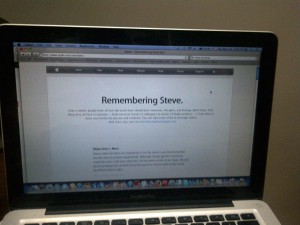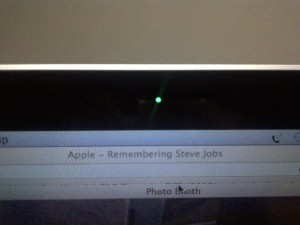Apple’s Innovation Method ? – Part 2 – SIP
TweetProlog
Please read Part 1 of this series, to understand the context better.
Reading the Tea Leaves
Once the iPod became successful, stories of how it got made were written up and one of the stories which covered – how the iPod came to be that small caught my attention. In that story, the following lines were telling:
The engineers explained that they had to reinvent inventing to create the iPod, and that it was simply impossible to make it any smaller. Jobs was quiet for a moment. Finally he stood, walked over to an aquarium, and dropped the iPod in the tank. After it touched bottom, bubbles floated to the top.“Those are air bubbles,” he snapped. “That means there’s space in there. Make it smaller.”
INC.: Where do great products come from?
JOBS: I think really great products come from melding two points of view—the technology point of view and the customer point of view. You need both. You can’t just ask customers what they want and then try to give that to them. By the time you get it built, they’ll want something new. It took us three years to build the NeXT computer. If we’d given customers what they said they wanted, we’d have built a computer they’d have been happy with a year after we spoke to them—not something they’d want now.
INC.: You mean the technology is changing too fast.
JOBS: Yeah, and customers can’t anticipate what the technology can do. They won’t ask for things that they think are impossible. But the technology may be ahead of them. If you happen to mention something, they’ll say, “Of course, I’ll take that. Do you mean I can have that, too?” It sounds logical to ask customers what they want and then give it to them. But they rarely wind up getting what they really want that way.
Seemingly Impossible Problem (SIP)
I have made the keywords that really struck me into Red & Bold. I put two & two together and realized that Apple’s strategy is to find a Seemingly Impossible Problem (SIP) in a given space and solve it. Now as I ran through Apple’s recent products one by one, it fit the pattern – iPod solved the Seemingly Impossible Problem of having 1000 songs in your pocket, the iPhone solved the Seemingly Impossible Problem of having a Smartphone with no buttons…
Not just Apple’s successful products, failed products like Apple Cube solved a SIP. I found that certain features in Apple’s products are SIPs. For example, if you own a Macbook Pro, you will be surprised to know that the Green light that shows up when you turn on the camera, is done without any holes at all! [Please read this write up in the Businessweek on that SIP ]. The picture below of my Macbook Pro shows the front face without any visible hole for the green light to shine through.
The picture below of my Macbook Pro shows the Green Light which is coming without any visible hole on the Laptop’s front face!
The fingerprint sensor that works like magic on the iPhone 5S is an SIP – those that have used the pathetic fingerprint scanners on laptops can attest to the iPhone 5S’ innovation 🙂
Laws of Subtraction
As I was researching SIPs further, by some sheer coincidence, a colleague of mine Sanjay Radhakrishnan handed me Mathew May’s brilliant book The Laws of Subtraction. In that book, May gives several examples of SIPs in the chapter Laws of Subtraction No. 4 – Creativity Thrives Under Intelligent Constraints:
Brian Muirhead, Mars Pathfinder Team Leader was asked to build with $150MM in 3 years, when the previous mission Mars Observer took 10 years & $1B to do it. ….. It was and remains one of the most compelling examples of how to use seemingly impossible constraints to tap into and guide human creativity in a team setting.
Lexus Chief Engineer Ichiro Suzuki, issued the Challenge of producing a luxury performance sedan that would beat the best luxury sedans – BMW 735i and Mercedes 420SEL – across the board in comfort, styling, performance, handling, cabin noise, aerodynamics, weight, and fuel sufficiency. …….. The reaction from the 1,400 engineers involved was unanimous :impossible.
More SIPs
Obviously, choosing an SIP strategy is audacious and many firms and teams won’t even try. But that is a topic for some other time. Sticking with SIPs, over time, I found several more examples – Boeing 727, GMail and examples from India – TATA Nano, Titan Edge. You can also see the SIP signature in Google’s attempts – Driverless Cars, non-invasive Glucometry using a smart Contact Lens etc.
I was pleasantly surprised to see Google hiring Regina Dugan (ex DARPA) to head their skunkworks labs. And here is what she says in an interview:
In June at Google I/O, the company’s developer conference in San Francisco, for example, she filled her presentation on her Motorola work with catchy—and sometimes trite—one-liners that mixed showmanship and bravado. “Here we don’t tinker,” she said. “We build new things, sometimes seemingly impossible things.”
Epilog
Now a string of success stories, does not a theory make. When does the SIP strategy not work? Closer to home the TATA Nano, while an SIP, did not achieve the success it was expected to attain, the Apple Cube was a big flop. Why does that happen? Understanding this is crucial to applying the SIP strategy. Will cover it in the next post. Stay tuned.
Updated Oct 2, 2014: Links to Part 1 and Part 3 of the series.



Excellent post Sukumar, wonderfully narrated with examples that support your hypothesis. I loved the way you have framed the way apple goes about finding problems – “Apple’s strategy is to find a Seemingly Impossible Problem (SIP) in a given space and solve it.”
Thanks for mentioning me
In the case of the Nano and the Apple Cube, I wonder if they got the need wrong (i.e did not frame the SIP correctly). I look forward to Part 3
Thanks a lot Sanjay. Glad you liked the post. Yes, in the case of Nano and Apple Cube, they got the need wrong and hence the SIP was not framed correctly. The question is, why did they do that? Stay tuned.
I concur that Apple is trying to solve SIPs. Regarding iPod, it was “Jon Rubinstein” who went to Toshiba and cracked the final puzzle of how to put 1000 songs in an iPod.
Apple in many ways think ahead and push the technology forward but sometimes they reinvent the wheel if they believe that the old wheel is not good enough. e.g fingerprint sensors
I wonder whether their surplus capital and their brand gave them power to solve SIPs. For example Apple pay is an SIP. Google tried it but failed but Apple cracked it because it has got market power to dictate certain terms to all the retailers. Ofcourse Apple offered a simple seamless way of doing purchases without credit card and cash.Do you think Apple’s power as a market leader allow it to solve SIPs ?
Thanks Selvaraaju. Not sure capital & brand are critical. When the iPod was introduced, Apple was in a very bad shape financially. While their brand was somehow surviving it didn’t have quite the cachet it has today. I think to solve SIPs, it requires a team (leader included) which is gutsy enough to solve a tough problem. Steve Jobs had that kind of courage and he had assembled a great team that could execute on his courageous approach. Hope that helps. BTW, you had mentioned in part 1 of this series that you had some fascinating things to share about Apple. Do you mind sharing them?